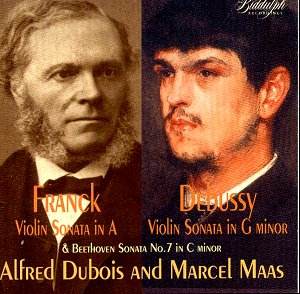This is a disc even more impressive than Biddulph’s
collection of Bach recordings made
by these duo partners in the 1930s. If the Beethoven betrays some
idiosyncrasies it’s always engaging but the Dubois-Maas heartland
of the Franco-Belgian repertoire could not be more persuasively
explored than by these two embodiments of style and tonal nuance.
Dubois was born in 1898 and studied in Brussels. After leaving
the Conservatoire he moved in Ysaÿe’s orbit between the years
1917 and 1920, won prestigious competitions and teamed up in a
sonata duo with Marcel Maas. After his mentor’s death he was the
pre-eminent Belgian soloist, a position he was to hold for the
rest of his sadly curtailed life. A late 1930s tour of America
couldn’t be cemented because of the outbreak of war, during which
he formed a quartet and taught – his most famous pupil being Arthur
Grumiaux; both were superb Bach players – and he taught at the
Brussels Conservatoire for over twenty years. He died in 1949.
Maas’s career of course is more widely known – he lived on into
the age of the LP but his earlier recordings may come as a welcome
exploration of his youthful sonata playing.
The Beethoven Sonata, as I said, has its peculiarities.
It may seem somewhat brusque at moments but the compensations
are Maas’s beautiful clarity in the slow movement, the splendid
balance between the two, their ability to sustain slow tempi,
and Dubois’s classical lyricism and subtle bowing arm, those greater
gradations of colouristic potential that players of the Franco-Belgian
schools found. Dubois’s delightful little inflexions animate the
finale wonderfully well.
I have to admit that when it comes to listening
to the Franck I sometimes find myself wondering, not to put too
fine a point on it, where exactly I am in the work. Some performers
seem incapable or unwilling to distinguish paragraphs and movements;
the work becomes sectional, undifferentiated and uniform, a cyclical
exercise in static music making. Even fine musicians come badly
unstuck, as badly as they do for different reasons in the Mendelssohn
Violin Concerto. Music critics can shower superlatives like confetti
or denigrate with easy aplomb – but this really is a magnificent
performance. Dubois is neither smeary nor tensile; his portamenti
are acutely judged and employed without an obvious intermediate
note. Maas is reflective, his bass weighted sensitively. The sense
of musical and emotive deliberation is palpable, their shading
of colours and of volume in no way vitiated by a couple of little
violinistic intonational buckles toward the end of the first movement.
Dubois varies his intensity of phrasing in repeated passages,
adjusts his vibrato and together with Maas characterises each
movement with absolute authority. In a performance such as this
the sense of emotional engagement, expressive intimacy and of
musical inevitability are paramount. The tempo of the finale,
as elsewhere, seems just right, the elasticity and drama unfolded
with perfect judgement. Of all the performances I’ve heard of
this work – even Thibaud and Cortot’s, even Heifetz’s – none seems
to me to make more musical sense than this one, and few sound
so attractive and sympathetic.
The Debussy should be meat and drink to Dubois
and Maas and indeed it is. There is an idiomatic freshness in
the playing, a perfect accommodation of the sonata’s changeability
and malleability. Dubois is here the living embodiment of the
Franco-Belgian school; not as sensuous or evocative a tonalist
as Thibaud, of course – who could be – but one whose tonal limits
work entirely directly and with sure fidelity. One can listen
to him for example in the Intermède as his tone becomes
suggestively leaner, as his portamento elegance moves incalculably
from refinement to rhythmic coyness. Dubois and Maas are true
partners and their performance is a true classic of the gramophone.
Tully Potter reprises his notes to this issue
and he is rightly laudatory. I suggested in my notes to the Bach
disc that Dubois was a connoisseur’s violinist. Be a connoisseur
and admire his remarkable musicianship.
Jonathan Woolf
